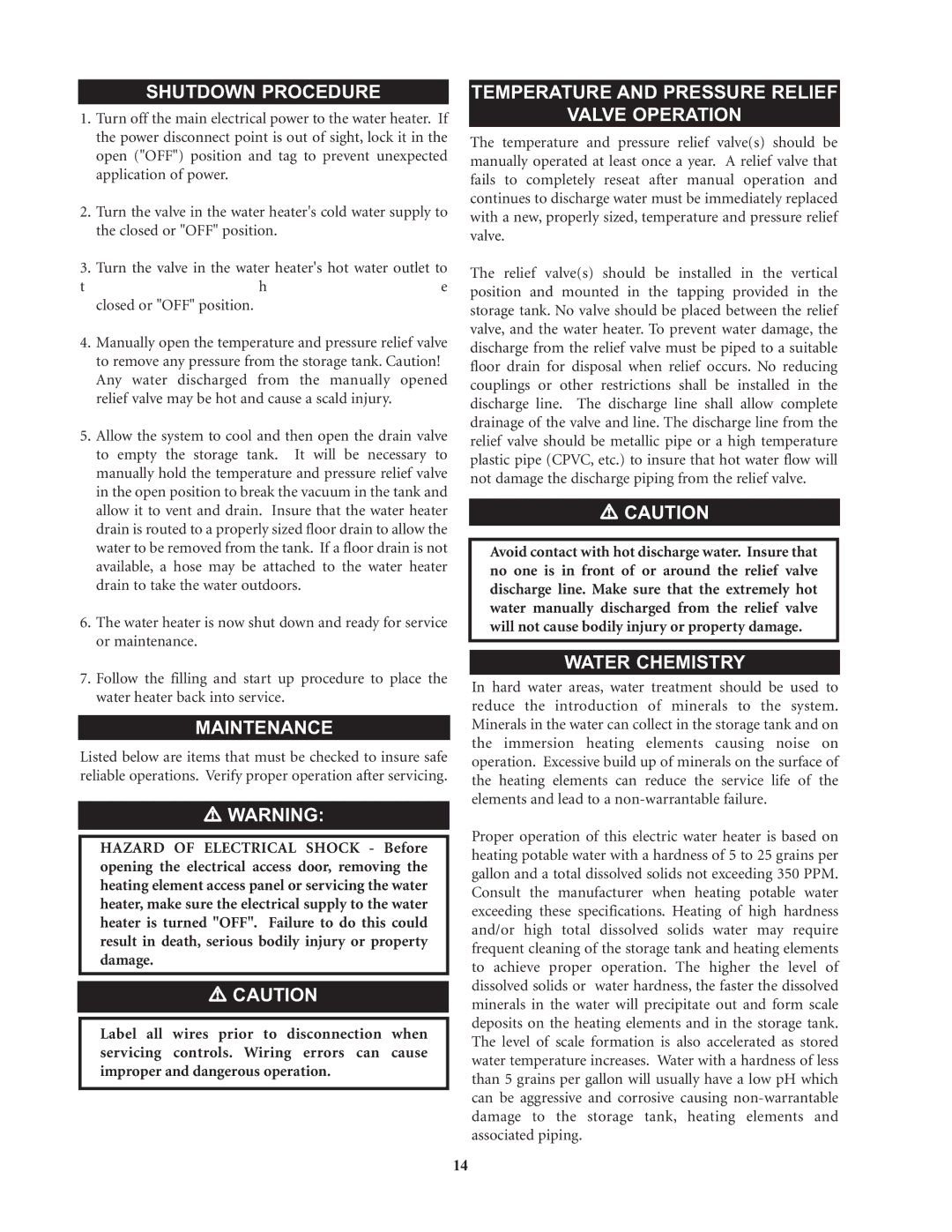
SHUTDOWN PROCEDURE
1.Turn off the main electrical power to the water heater. If the power disconnect point is out of sight, lock it in the open ("OFF") position and tag to prevent unexpected application of power.
2.Turn the valve in the water heater's cold water supply to the closed or "OFF" position.
3.Turn the valve in the water heater's hot water outlet to
t | h | e |
closed or "OFF" position.
4.Manually open the temperature and pressure relief valve to remove any pressure from the storage tank. Caution! Any water discharged from the manually opened relief valve may be hot and cause a scald injury.
5.Allow the system to cool and then open the drain valve to empty the storage tank. It will be necessary to manually hold the temperature and pressure relief valve in the open position to break the vacuum in the tank and allow it to vent and drain. Insure that the water heater drain is routed to a properly sized floor drain to allow the water to be removed from the tank. If a floor drain is not available, a hose may be attached to the water heater drain to take the water outdoors.
6.The water heater is now shut down and ready for service or maintenance.
7.Follow the filling and start up procedure to place the water heater back into service.
MAINTENANCE
Listed below are items that must be checked to insure safe reliable operations. Verify proper operation after servicing.
WARNING:
HAZARD OF ELECTRICAL SHOCK - Before opening the electrical access door, removing the heating element access panel or servicing the water heater, make sure the electrical supply to the water heater is turned "OFF". Failure to do this could result in death, serious bodily injury or property damage.
CAUTION
Label all wires prior to disconnection when servicing controls. Wiring errors can cause improper and dangerous operation.
TEMPERATURE AND PRESSURE RELIEF
VALVE OPERATION
The temperature and pressure relief valve(s) should be manually operated at least once a year. A relief valve that fails to completely reseat after manual operation and continues to discharge water must be immediately replaced with a new, properly sized, temperature and pressure relief valve.
The relief valve(s) should be installed in the vertical position and mounted in the tapping provided in the storage tank. No valve should be placed between the relief valve, and the water heater. To prevent water damage, the discharge from the relief valve must be piped to a suitable floor drain for disposal when relief occurs. No reducing couplings or other restrictions shall be installed in the discharge line. The discharge line shall allow complete drainage of the valve and line. The discharge line from the relief valve should be metallic pipe or a high temperature plastic pipe (CPVC, etc.) to insure that hot water flow will not damage the discharge piping from the relief valve.
CAUTION
Avoid contact with hot discharge water. Insure that no one is in front of or around the relief valve discharge line. Make sure that the extremely hot water manually discharged from the relief valve will not cause bodily injury or property damage.
WATER CHEMISTRY
In hard water areas, water treatment should be used to reduce the introduction of minerals to the system. Minerals in the water can collect in the storage tank and on the immersion heating elements causing noise on operation. Excessive build up of minerals on the surface of the heating elements can reduce the service life of the elements and lead to a
Proper operation of this electric water heater is based on heating potable water with a hardness of 5 to 25 grains per gallon and a total dissolved solids not exceeding 350 PPM. Consult the manufacturer when heating potable water exceeding these specifications. Heating of high hardness and/or high total dissolved solids water may require frequent cleaning of the storage tank and heating elements to achieve proper operation. The higher the level of dissolved solids or water hardness, the faster the dissolved minerals in the water will precipitate out and form scale deposits on the heating elements and in the storage tank. The level of scale formation is also accelerated as stored water temperature increases. Water with a hardness of less than 5 grains per gallon will usually have a low pH which can be aggressive and corrosive causing
14
